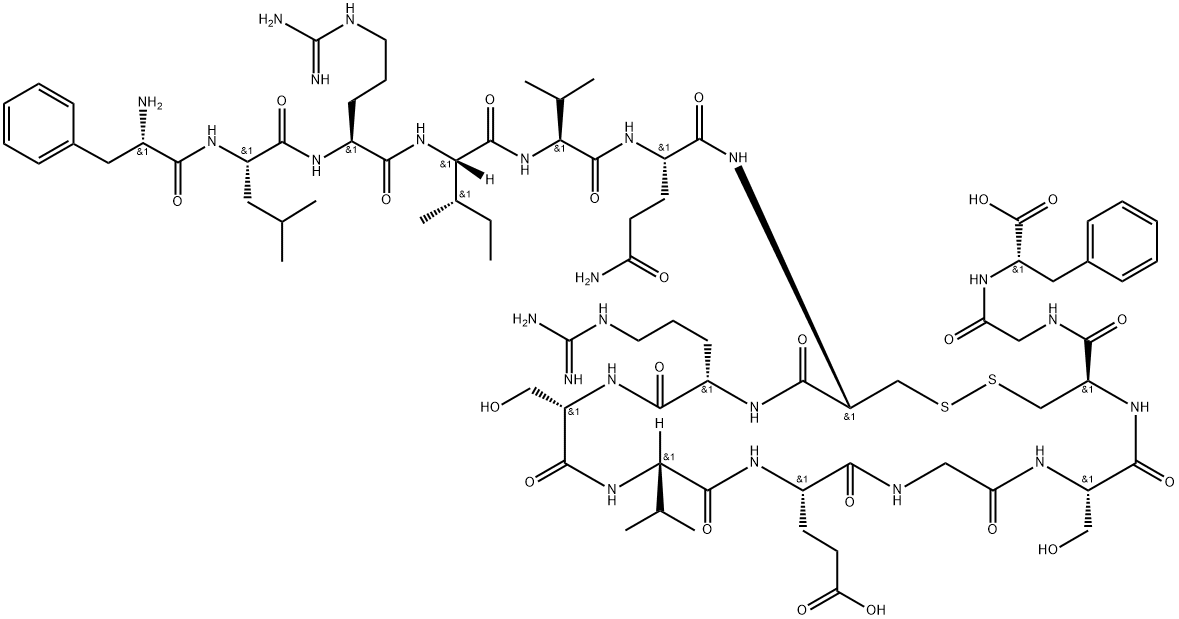- HGH Fragment 176-191
-

- $70.00/ kit
-
2025-04-30
- CAS:66004-57-7
- Min. Order: 1kit
- Purity: 99%
- Supply Ability: 10000kits
|
| | hGH 176-191 Basic information |
| Product Name: | hGH 176-191 | | Synonyms: | somatotropin (176-191);CL233;HGH Fragment 176-191 Trifluoroacetic acid;L-Phenylalanine, L-phenylalanyl-L-leucyl-L-arginyl-L-isoleucyl-L-valyl-L-glutaminyl-L-cysteinyl-L-arginyl-L-seryl-L-valyl-L-α-glutamylglycyl-L-seryl-L-cysteinylglycyl-, cyclic (7→14)-disulfide (9CI);HGH Fragment 176-191 (TFA salt);Growth Hormone Peptide Fragment HGH 176-191 Hgh Frag 176 Aod 9604;HGH 176-191 | | CAS: | 66004-57-7 | | MF: | C78H123N23O22S2 | | MW: | 1799.1 | | EINECS: | 200-001-8 | | Product Categories: | | | Mol File: | 66004-57-7.mol |  |
| | hGH 176-191 Chemical Properties |
| density | 1.47±0.1 g/cm3(Predicted) | | solubility | DMSO (Slightly), Methanol (Slightly) | | pka | 3.49±0.10(Predicted) | | form | Solid | | color | White to Off-White | | Stability: | Hygroscopic | | InChIKey | CRQXWEZWPKDKLW-OOGSZTHNNA-N |
| | hGH 176-191 Usage And Synthesis |
| Description | Growth hormone is a protein hormone of about 190 amino acids that is synthesized and secreted by cells called somatotrophs in the anterior pituitary. It is a major participant in control of several complex physiologic processes, including growth and metabolism. Growth hormone is also of considerable interest as a drug used in both humans and animals. | | Uses | HGH 176-191 is a synthetic part sequences of human pituitary growth hormone. HGH Fragment 176-191 had anti-insulin activity in rats in vivo and in vitro. | | Definition | Human growth hormone is composed of 4 major α-helices which are arranged in an up-up-down-down topology required for receptor interaction along with three mini helices. A C-terminal hGH fragment 176–191 with a tyrosine to phenylalanine substitution at the last position has been reported to enhance lipid breakdown and fat utilization in mice. Four peptides (hGH 172-191, 176-191, 177-191, and 178-191) produced a short-lived rise in blood glucose and a more sustained rise in plasma insulin, whereas the other two (hGH 179-191 and 180-191) were inert in the systems tested. Researches have found that Chitosan nanoparticles loaded with both doxorubicin and hGH fragment 176–192 peptide demonstrate both favorable physicochemical properties and enhanced cytotoxic efficacy against breast cancer cells. The inclusion of hGH fragment 176–192 peptide may promote accumulation of doxorubicin-loaded Chitosan nanoparticles in breast tumors while reducing non-target tissue exposure, thereby enhancing therapeutic efficacy and reducing side effects[1-2]. | | Indications | Somatotropin is indicated for the treatment of pediatric patients who have growth failure due to an inadequate secretion of endogenous growth hormone, short stature associated with Turner syndrome, Prader-Willi syndrome (PWS), idiopathic short stature (ISS), short stature or growth failure in short stature homeobox-containing gene (SHOX) deficiency, and short stature born small for gestational age (SGA). It is indicated for the treatment of growth failure in children associated with chronic kidney disease up to the time of renal transplantation.It is also indicated for adults with adult-onset growth hormone deficiency, either alone or associated with multiple hormone deficiencies (hypopituitarism), as a result of pituitary disease, hypothalamic disease, surgery, radiation therapy, or trauma. It is also used to treat childhood-onset growth hormone deficiency in adults due to congenital, genetic, acquired, or idiopathic causes. | | Pharmacokinetics | Somatotropin induces growth in nearly every tissue and organ in the body. It stimulates linear growth and cartilaginous growth of long bones. In children with short stature, growth hormone increases both the number and size of muscle cells. It also promotes the growth of internal organs, and it also increases red cell mass. By promoting nitrogen retention, growth hormone increases cellular protein synthesis. Growth hormone also retains potassium and phosphorus in the serum, which may be the result of cell growth. Growth hormone stimulates the synthesis of chondroitin sulfate and collagen and increases the urinary excretion of hydroxyproline. It has negligible effects on serum calcium levels. Although increased calcium excretion in the urine is observed, calcium absorption from the intestine is simultaneously enhanced. In end-stage renal disease, growth hormone was shown to improve several nutritional parameters, such as increases in serum insulin-like growth factor-I (IGF-I), serum albumin, and transferrin, as well as a reduction in blood urea nitrogen. | | References | [1] Ng F, et al. Hyperglycemic action of synthetic C-terminal fragments of human growth hormone. American Journal of Physiology-Endocrinology and Metabolism, 1978; 234: E521-6
[2] Habibullah M, et al. Human Growth Hormone Fragment 176–191 Peptide Enhances the Toxicity of Doxorubicin-Loaded Chitosan Nanoparticles Against MCF-7 Breast Cancer Cells. Drug Design, Development and Therapy, 2022; 16: 1963-1974.
|
| | hGH 176-191 Preparation Products And Raw materials |
|